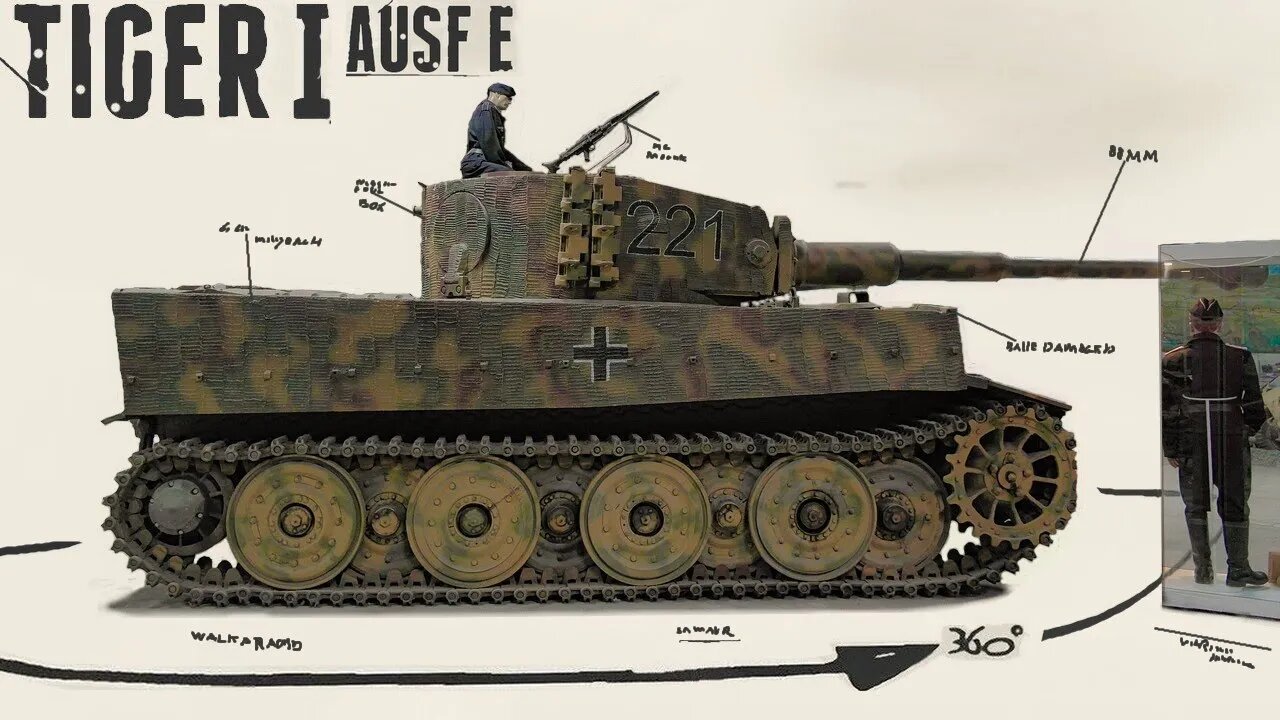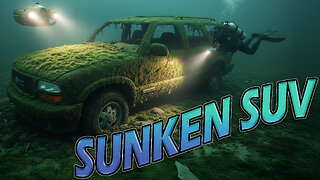Premium Only Content

Tiger I Ausf. E - Walkaround - Musée Des Blindes.
Originally uploaded on 18 jun. 2016
The Tiger I was a German heavy tank developed in 1937 by
Henschel & Sohn when
the Waffenamt requested Henschel to develop a Durchbruchwagen.
this would result into the Durchbruchwagen I,which would never be fitted
with a turret and was replaced by the Durchbruchwagen II
after the request for a heavier 30-tonne class vehicle with thicker armour.
The project was dropped in 1938 in favor of the larger and
better-armoured VK 30.01 (H) and VK 36.01 (H),
these vehicles would use the complex over-engineered
Schachtellaufwerk track suspension system of torsion bar-sprung,
overlapped and interleaved main road wheels,
which would later become problematic when jamming solid in the winter.
Four prototype hulls were completed for testing.
Two of these were later modified to build the "Sturer Emil"
self-propelled anti-tank guns.
In 1941 with the experience of the Battle of France, Henschel and
Ferdinand Porsche were asked to submit designs for a 45-tonne heavy tank,
to be ready by June 1942.
Porsche worked on an updated version of their VK 30.01 (P) Leopard prototype
while Henschel worked on an improved VK 36.01 (H) tank.
Henschel built two prototypes: a VK 45.01 (H) H1 with an 8.8 cm L/56 cannon,
and a VK 45.01 (H) H2 with a 7.5 cm L/70 cannon.
Porsche and Henschel submitted prototype designs,
each making use of the Krupp-designed turret.
The Henschel design was accepted, mainly because
the Porsche VK 4501 (P) prototype
design used a troubled petrol-electric transmission system.
Production of the Panzerkampfwagen VI Ausf. H began in August 1942.
The tank was given its nickname "Tiger" by Ferdinand Porsche,
and the Roman numeral was added after the Tiger II entered production.
The initial designation was Panzerkampfwagen VI Ausfü.H,
the H was re-designated as PzKpfw VI Ausf. E in March 1943.
The Tiger was still at the prototype stage when it was first
hurried into service, and therefore changes both large and small
were made throughout the production run.
A redesigned turret with a lower cupola was the most significant change.
To cut costs, the river-fording submersion capability and
an external air-filtration system were dropped.
It would first see action near Leningrad on 23 Sep. 1942
months earlier than had been planned.
A platoon of 4 Tigers went into action, they could not operate in swampy,
forested terrain, their movement was largely confined to roads and tracks,
also many of these early models were plagued by problems with the transmission
and many broke down, the Soviets also captured one Tiger largely intact,
it enabled the Soviets to study the design and prepare countermeasures.
In the North African Campaign, the Tiger I first saw action during the
Tunisian Campaign on 1 December 1942 east of Tebourba.
The tanks proved that they had excellent protection from enemy fire,
this greatly increased the crews trust in the quality of the armour,
the crews also found the tank to be spacious and comfortable.
The Tiger proved to have great armament and
was a outstanding design for its time,
its armour which was resistant to tank and anti-tank guns of the time.
and the 88 could knock out enemy Sherman tanks
at 2,100 m and the T-34 at 1500 m,
but with Allied tanks becoming more up-armored
and upgraded and having better guns like the M3 90 mm cannon used
on the M36 tank destroyer,
made the Tiger vastly obsolete in the end.
This Tiger with Fahrgestell number 251114, was made in the Henschel und Sohn, Kassel, Nordhessen, Germany and the turret was made at Henschel und Sohn, Kassel, Nordhessen, Germany.
This Tiger came from the sSSPzAbt 102, turret number 114 it was captured by the French,
and got named Colmar. Several of these machines were re-employed, but not in sufficient number to form a complete unit.
After the war it was placed into storage and shipped to the Saumur collection.
This Tiger got send to the Munster Panzer Museum, Germany in 2003-2004, were it got a new paintjob and Zimmerit.
■ So want to help keep me and the channel going?
supporting me on Patreon will get you access to extra content for three channels in total.
■ Support me on my Patreon https://www.patreon.com/Panzerpicture
■ Store: teespring.com/stores/panzerpicture-2
■ Information obtained from several sites.
■ Wikipedia
■ tanks-encyclopedia
■ the.shadock.free.fr/Surviving_Panzers
■ preservedtanks
■ pantser.net
■ the.shadock.free.fr/Tanks_in_France
■ Some music is from the YouTube Audio Library.
■ Music used:
EpidemicSound.com
Copyright fair use notice
All media used in
this video is used for
the purpose of education
under the terms of
fair use.
All footage and images
used belong to their
copyright holders.
-
 LIVE
LIVE
vivafrei
21 hours agoEp. 278: D.C. Peace Wave! Big Tish & Nipple Judge SPANKED! "Maryland Man" Trafficker FREE & MORE?
7,141 watching -
 LIVE
LIVE
Nerdrotic
1 hour agoMysteries of 3I/ATLAS | Forbidden Frontier #113
576 watching -
 11:52
11:52
Exploring With Nug
50 minutes agoWhat’s Hiding Under This Dallas Lake We Found a Vehicle!
654 -
 LIVE
LIVE
Barry Cunningham
7 hours agoBREAKING NEWS: PRESIDENT TRUMP SET TO TAKEOVER CHICAGO AND BOSTON!
1,461 watching -
 LIVE
LIVE
SpartakusLIVE
1 hour agoThe BADDEST Duo in WZ Exhibits PEAK Physique || Duos w/ Sophiesnazz to start, quads later
570 watching -
 LIVE
LIVE
LumpyPotatoX2
1 hour agoSunday Funday on HellDivers - #RumbleGaming
86 watching -
 3:11:52
3:11:52
Esports Awards
4 hours agoEsports Awards: Decade Awards 2025
41.2K3 -
 1:02:58
1:02:58
Sarah Westall
2 hours agoMILITARY WHISTLEBLOWER: How Social Media Military Level Psyops are Manipulating You w/ Patrick Bergy
6.03K3 -
 30:41
30:41
Stephen Gardner
2 hours ago🔥WHITE HOUSE GETS UNEXPECTED BIG WIN!
10.4K10 -
 9:39
9:39
MattMorseTV
4 hours ago $0.31 earnedVance just DROPPED a BOMBSHELL.
10.4K41